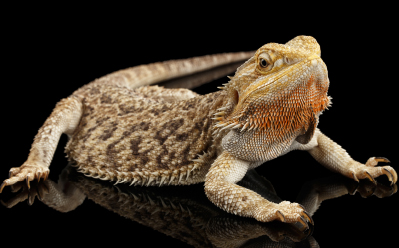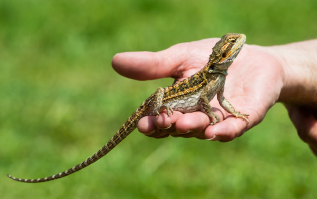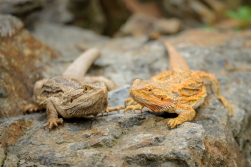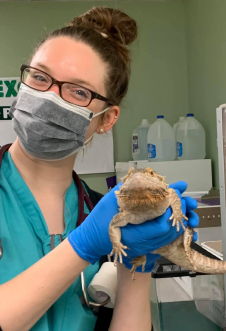By Lana Van De Mark
Adopting a pet is a long-term commitment that involves a tremendous amount of passion, time, and research to ensure that we provide them with the healthiest and happiest lifestyle they deserve. Cold-blooded animals, especially bearded dragons, require particular care that involves adequate understanding of their native habitat and acquiring advice from experts such as veterinarians who specialize in the care of reptiles before bearded dragon lovers welcome one into their home for the first time.

Native to the semi-arid, rocky desert regions of Central Australia, Central Bearded Dragons (Pogona Vitticeps), are one of eight bearded dragon species found in the land down under and the most common type of bearded dragon bred and adopted in the U.S. pet trade today. It is believed that these lizards first evolved around 250 million years ago.
The bearded dragon name was coined from the spiky skin underneath their chins that puffs out when they feel threatened, stressed, or incredibly happy. Bearded dragons come in assorted colors and are commonly referred to by their nickname, “beardies.” Since Australia banned the import of bearded dragons, U.S. breeders have been keeping the bearded dragon pet trade alive for the past three decades and making adoption of these fascinating and people-friendly lizards possible.

THE BEST ADVICE
Avian and exotic pet veterinarian, Dr. Frank Boren, has been treating bearded dragons, dogs, cats, small mammals, birds, and other reptiles for the past 35 years at Oradell Animal Hospital in Paramus, NJ. He is also a consultant for The James A. McFaul Environmental Center in Wyckoff, NJ and formerly served as veterinarian for the Bergen County Zoo.
Although bearded dragons are one of the most interactive and easiest lizards to raise, the process can be tricky and overwhelming if beardies are not properly cared for. This is where expert advice can be beneficial for inexperienced bearded dragon owners.
RAISING BEARDED DRAGONS
Diet A bearded dragon’s diet is extremely important to their long-term development and growth and should be like what they eat in the wild. Bearded dragons are omnivores, so they require a balance of nutrient rich vegetables, fruit, weeds, and insects. Some of these can include collard greens, kale, bell peppers (raw), dandelions, strawberries, mealworms, crickets, and the like.
Foods to avoid due to toxic acidic levels or limited nutritional content include oranges, mushrooms, onions, celery, and rhubarb. Because bearded dragons grow extremely fast and require a specific diet plan at various stages of life, we advise you to consult a vet who specializes in exotic animals.

Young beardies need a high calcium diet to prevent Metabolic Bone Disease. Dusting non-phosphorous and vitamin-free calcium powder on live insects prior to feeding time is recommended. Additional vitamin supplements should only be used a couple times a month, as “overuse of vitamin mixes can lead to kidney problems,” Dr. Boren explains.
Live insects also offer a more adequate source of nutrition over dead insects because dead insects can’t be fed the gut-loaded nutrients they absorb when they’re alive. “All insects are calcium deficient and need to be fed a high calcium diet prior to being fed to the reptile,” says Dr. Boren. Insects should also be fed in moderation since they’re high in fat and can lead to obesity. Overfeeding beardies in general can lead to Hepatic Lipidosis and liver failure. Fasting for one day is recommended once a week since this reproduces conditions in the wild when food sources are scarce.
To learn more about Bearded Dragon diets, visit thebeardeddragon.org

Housing Bearded dragon enclosures should mimic their native habitat as much as possible to thrive in captivity. Since they come from a warm climate, they require a basking spot between 88 - 100 degrees, a cool down spot between 75 - 85 degrees, night-time temperature between 70 -75 degrees, an ultraviolet light source, and humidity range between 20 -40 percent. These conditions can be maintained with a 100-watt reptile basking bulb, a 10-13-watt ultraviolet bulb for small enclosures/100-watt ultraviolet bulb for large enclosures, a temperature and humidity gauge, and ceramic heat emitter. Since bearded dragons are diurnal (awake during the day/sleep at night), they require 10 - 12 hours of lighting and 10 -12 hours of darkness. Ultraviolet bulbs should be replaced every six months and basking bulbs every 12 months.

Since beardies can grow up to two feet long, a 75 – 100 gallon enclosure is recommended to allow them adequate space to thrive. A 40-gallon enclosure is suitable for younger beardies, but after time they will outgrow them and need to be housed in a larger one. They should not be housed with other beardies once they become adults due to their territorial nature. Bearded dragons love to climb and hide, so adding trees, branches, rocks, and places to hide to their enclosure is essential.
Items such as newspaper, paper towel and reptile carpet are best to use since sand can be harder to keep clean and can be accidentally consumed. Be cautious of any loose threads with reptile carpet so the beardie’s claws don’t get tangled. Keeping beardies hydrated in captivity is also essential, “many desert species such as beardies do not like to drink from a bowl. They can be soaked once or twice weekly and the owner can dribble water on their head for them to lick,” says Dr. Boren. Misting them once or twice a day from behind is another alternative.
To learn more about housing beardies visit seavs.com
Handling When handling beardies, it’s important to be mindful of the potential diseases reptiles can carry like Salmonella, “Salmonella can be shed in the feces of any animal potentially. People can become infected if they inadvertently ingest infected fecal matter. Washing hands before and after handling reptiles with disinfectant soap will eliminate this risk in most cases,” Dr. Boren explains. Children should be supervised when handling reptiles to make sure they wash their hands properly. Beardies should also be supervised around other pets in the house such as cats and dogs. Beardies can co-exist peacefully with them under the same roof if they are trained from day one. Reputable websites such as zoo or veterinary college websites are recommended for conducting proper research on beardies.
To learn more about Salmonella, visit arav.org












